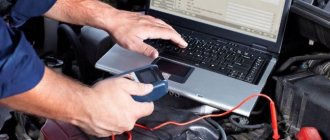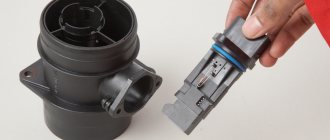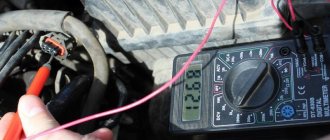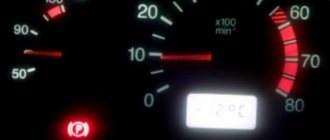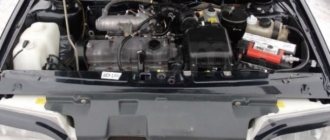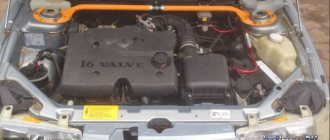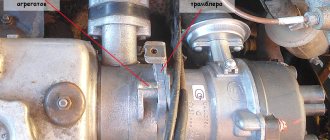Kamaz 5320 revs fluctuate
Problem: KamAZ Euro-3 740 idle speed floats, the engine takes a long time to start, stalls when releasing the gas and when changing gears
Diagnostic result: As in most cases with similar symptoms:
We have made a diagnosis: wear of the pump, namely the plunger pairs. Although their condition, one hundred percent, can be confirmed after rolling the pump on a stand, disassembling and troubleshooting.
From experience, I can say that pump wear is not the only reason for floating speed in KAMAZ.
Solution: Firmware has been installed with which the ECU (engine control unit) operates taking into account pump wear.
Result: The Kamaz starts with half a turn, the idle has leveled off and stands at 600 rpm. In other words, the problem is solved.
We have done quite a few similar procedures. And this solution is very rational and cost-effective, because a new pump costs about 150 rubles, and its repair costs about 80. And after replacing the firmware, the pumps work 1.5-2 times longer.
Of course, when the pump is physically destroyed (the plunger pairs are killed) and chips are rushing out of the return (we also encountered this), then no amount of firmware will help. Such cases are rare and a positive result is achieved in 95%.
We have been practicing this method of solving this problem for a long time. Clients are satisfied and recommend us to others.
Bonus: When replacing the firmware, the engine power was increased from 280 to 320.
The main malfunctions of KAMAZ engines and possible solutions to them.
1. Low pressure in the engine
The problem may be wear of the liners, but first we check and clean the oil pump. First, check that the pressure relief valve is not stuck. It has a separate radiator section responsible for cooling the oil. Overheated oil can also cause a drop in pressure. At idle speed when hot, the pressure should not drop below 0.8 with a tachometer reading of 600 rpm. At 2600 rpm, the pressure should be at 3.5 - 4 on the mechanical sensor. If the oil pressure is low, also check the fastening of the oil intake with the pan removed and the presence of a gasket under it.
2. Increased fuel consumption
As the practice of operating KAMAZ trucks shows, this truck consumes 35–40 liters of diesel fuel, despite the striking differences in fuel consumption rates recorded in the passport. When consumption increases, this indicates a clogged oil filter and the need to change the oil. Also, the use of low-quality fuel increases the consumption of diesel fuel. Consumption increases when a trailer is hitched. In the urban cycle it is consumed 7-8% more than on the highway.
IAC cleaning
Do-it-yourself troubleshooting of the idle air regulator consists of simply washing it to remove carbon deposits. To do this you need to follow the instructions:
- disconnect the wire plug from the sensor;
- Unscrew the two fastening screws with a small shaped screwdriver and remove the sensor from the mounting socket;
- Clean the needle cone using WD-40 or carburetor cleaner.
The same means can be used to wipe the regulator contacts and the entire throttle assembly.
Throttle valve
When the driver presses the gas pedal, the throttle valve opens, allowing more air into the combustion chambers. Oxygen is mixed with fuel, after which the prepared mixture burns. The more the driver presses the gas pedal, the wider the throttle opens and the more air flows in. But often carbon deposits accumulate on the walls of the damper, and its loose closure causes disturbances in the operation of the power plant.
The throttle assembly is located behind the engine air filter. This arrangement is typical not only for the Lada Kalina, but also for many other cars. Depending on the engine type, the damper operation can be controlled by an electronic gas pedal or a cable drive.
Many car enthusiasts have come across the concept of floating engine idle speed. For the Lada Kalina, as practice shows, this is a common malfunction that can be fixed with your own hands, but sometimes you will need to use a car service.
RPM fluctuates at idle
This may be due to many factors.
Let's consider the main reasons for the occurrence of floating engine speeds:
- Fuel system malfunction
.Malfunction of fuel system elements
- Ignition problems
.Problems with the ignition switch or wiring
- ECU errors
.Troubleshooting ECU errors
- Poor quality fuel
.Low-quality gasoline directly affects the operation of the power unit
All these reasons contribute to the appearance of such an effect. The most common reason is problems with injection.
Treatment methods
So, let's consider the sequence of actions to eliminate the causes of floating engine speed.
Fuel system
As practice and experience show, floating speeds appear in the event of an uneven supply of fuel to the combustion chambers, or a constant change in the amount of the fuel mixture.
Cleaning a removed injector
First of all, this is due to the injectors, which may be dirty. At the same time, this may not be felt when driving, but at idle the tachometer will immediately show it. Therefore, it is necessary to dismantle and check the injectors on a special stand.
Clean fuel pump mesh
Also, the malfunction may be caused by a breakdown of the gasoline pump, which does not supply fuel evenly or a clogged fuel filter. If necessary, you need to replace the filter element and check the fuel pump.
Cleaning the throttle body
A change in the amount of fuel mixture may be due to a clogged throttle or worn air filter. Therefore, the filter element changes, and...
Removed throttle before and after cleaning
Ignition problems
Problems with idle speed may occur due to incorrect operation of the ignition system. Namely, it may be related to the lock or wiring. So, it is worth checking and, if necessary, replacing damaged elements. It is best to change the ignition switch assembly and test the wires that go from it to ensure they are working properly.
ECU errors
Often, a car malfunction is associated with, as well as a malfunction of the controllers on the board. Of course, another reason could be the firmware that is out of order. Many car enthusiasts change the operating system, but this does not always help.
ECU removed from the vehicle
As practice shows, an ECU malfunction can pose a problem for the performance of many systems. Therefore, if the fault cannot be eliminated using the previous methods, it is necessary to replace the control unit. Of course, installing the operating system from the Lada Kalina Sport K-Line can help, but the problem does not always disappear completely.
Poor quality fuel
In many cases, poor quality of the fill can cause clogging of the fuel pipeline and injection system, which in turn gives the effect of uneven fuel supply. To eliminate the malfunction, you should drain the old fuel, clean the fuel system and fill in with new high-quality gasoline.
It is worth understanding that not only the operation of the engine, but also its durability depends on the quality of the fuel.
KamAZ engine smokes
White smoke from the exhaust pipe is normal if the KamAZ engine is started at negative outside temperatures. The water particles in the fuel are simply transformed into steam, which is a natural process. White smoke also occurs when coolant gets onto the cylinders due to natural wear of the intake manifold gasket or damage to the cylinder head.
If the engine in a truck smokes black, the reason is a malfunction of the fuel system, when hydrocarbons do not burn and turn into soot. This is due to a clogged fuel filter, oil getting into the combustion chamber when the rings stick, or cracks in the liners or pistons.
What to do if the engine stalls at idle when cold
In general, in a situation where the car stalls a few seconds after starting the engine, it is necessary to perform one or more of the following repair measures:
Perform an air line inspection. In particular, tighten all fastening clamps, replace old hoses with new ones if they are damaged, it is also advisable to change the air filter. It is also advisable to check the condition of the throttle valve. If it is very dirty, then air will leak into the system through it. Accordingly, it must be cleaned using carb cleaner or a similar cleaning agent. For some car owners, the problem is solved by replacing the O-rings on the intake manifold. It makes sense to check the pipes through which fuel is supplied and goes into the return line.
Clean the idle speed check valve. This unit works differently on different machines. Most often it is driven by a stepper motor. If the valve is dirty, it must be cleaned with a cleaner, and at the same time it is advisable to inspect the drive motor.
Use suitable and high-quality fuel. It happens that the problem is solved by literally changing the gas station. If we are talking about diesel fuel, then in winter you need to use winter diesel fuel, not summer diesel fuel, since summer diesel fuel crystallizes faster in cold weather, and this can lead to a situation where the engine starts and stalls when cold. It’s better to refuel at gas stations that sell high-quality fuel.
Check sensors. The DTOZH (coolant temperature sensor) may have problems with damage to the housing, oxidation of contacts, damage to the “chip”, and damage to the wire insulation. You can check the temperature sensor yourself in a garage by removing it or directly on the seat. For this you will need a thermometer and a multimeter. Malfunctions of the TPS (throttle position sensor) include loss of contact on the slider, wear of the contacts, wear of the gears, damage to the wires, their breakage or the occurrence of a short circuit in its circuit. And to determine malfunctions of the mass air flow sensor (mass air flow sensor), you can determine it by one of three methods - visual inspection, by turning off the power supply to the sensor, using a tester.
Check the operation of the idle air control. is performed using a visual inspection, an electronic multimeter or a special “control”. The faulty one is replaced with a new one.
Check the condition of the speed controller (if equipped). In particular, its purity. If it is significantly dirty, it must be cleaned using carb cleaner or another cleaner.
Check the operation of the injectors. It is advisable to carry out a comprehensive diagnosis of them along with cleaning
However, in this context, it is important to understand whether the injectors are keeping the fuel off. If they don’t hold, you need to perform additional diagnostics, including replacing the injectors with new ones.
Check the operation of the spark plugs
In particular, their general condition, the condition of the insulator, electrodes, and fastening threads. If the spark plug/plugs are significantly worn or damaged, they must be replaced with new ones, especially if the car’s mileage is suitable for their scheduled replacement.
Fuel pump relay. Check the relay and the operation of the fuel pump as a whole.
Fuel pressure control. If it fails, the problem is solved by replacing it with a new one. Diagnosed by measuring the pressure in the line.
For vehicles equipped with carburetor engines, it is necessary to check the presence of vacuum in the carburetor, intake manifold and vacuum hoses. You also need to check the carburetor settings, idle speed settings (usually adjusted with an adjusting bolt), and adjust the valves.
Conclusion
As practice shows, finding the reason why it stalls when cold is a rather complex and time-consuming task. Especially for fuel-injected cars that work with a large number of sensors. Therefore, first of all, it is necessary to connect an electronic ECU error scanner in order to decide “which direction to dig in” and which node to diagnose first. But, most often, the engine stalls when cold as a result of air leaks or problems with the fuel supply to the combustion chamber.
Possible causes of failure
Often, when idling, the car does not stall immediately. This process begins with a strong drop in engine speed, while the sensor indicates normal operation of the system. The engine runs unstable for some time, after which it simply stalls.
You should not immediately call a tow truck or cling to another car. Soon the mechanisms will stabilize and the car will be able to continue moving. But this problem arises more than once, because the reason lies in the mechanics of the car. Therefore, at the first symptoms and cases, it is worth addressing it.
Main reasons
The car may stall after starting the engine for several reasons, both when it is cold when first starting, or when it is hot. The problem manifests itself on injection and diesel units, for which there are quite a few reasons: from lack of fuel to more complex malfunctions associated with the fuel line or even the engine. It is necessary to identify as early as possible the reason that the engine starts and immediately stalls. Otherwise, the car will not be able to be used.
When cold the engine starts and immediately stalls.
There are several simple reasons why a car may stall immediately after the engine starts:
- Running out of fuel is a simple reason, but because of this it is often overlooked. During long breaks in operation, fuel condensate may drain from the walls of the tank, with which the car can start. There is not enough gasoline for further operation, which is why the car stalls.
- Bad diesel or gasoline - if the fuel was purchased at dubious gas stations, the composition contains additives, even water. They have a bad effect on the fuel system and its filters. Additional Information! In diesel engines, paraffin added to the diesel composition can harden. Its particles clog the filter that cleans the fuel, causing the pressure on the fuel line to drop.
- Car alarms - advanced security systems can not only trigger when installed in a car, block the steering wheel locks, but also prevent the engine from running. If such a system is installed, you should check its deactivation.
- No vacuum - This problem occurs in carburetor cars if there is air in any part of the fuel supply. This could be the carburetor itself, the intake manifold, or the vacuum hose. The mixture of fuel and air has completely different proportions, which is why the engine cannot operate normally.
- Low idle speed is a common problem in carburetor cars, because in injection cars the speed is adjusted automatically. You will need to manually adjust the idle speed with the carburetor. It can correct the situation, since the engine will consume a normal amount of gasoline.
These are the main reasons why there are problems with starting cars, including carburetor-type ones. But there are still injection machines that require consideration.
The engine starts and the injector immediately stalls
An injector is a part that injects fuel into the engine and is sensitive to voltage changes. There are a number of reasons why an injector stalls:
- problems with the fuel system: the fuel pump is checked. This is easy to do; you need to turn on the ignition; if you hear a buzzing sound, the pump is working. If there are no sounds, you need to check whether voltage is supplied to it;
- dirty throttle: if the idle air control is contaminated with carbon deposits, air passes through it less easily, which means the engine operates in abnormal mode. A breakdown of the throttle valve also plays a role: if it is closed, no air enters the engine;
- Ignition system problem: If the fuel system and air supply are operating as normal, check for sparking. The spark plugs are being studied, they should be unscrewed, cleaned, and checked for a spark. The easiest way is to attach an armored wire to the spark plug and crank the crankshaft with the starter. Damaged wires may be to blame for the situation; they can be checked with a tester and a megger. If they are not there, you should start the engine in the dark. If part of the system is damaged, high-voltage discharges can be seen on the coils, conductors and tips;
- breakdowns of sensors and ECUs: electronic engine management systems control all motor power elements using information coming from the sensors. If any of them are damaged, the power unit may not only stall, but also refuse to start. If there are problems with the ECU, you can find out about them by the “Check Engine” indicator on the dashboard. To find a fault, read errors using a scanner;
- “out of sync” of the valves: the valve timing in the car could be out of sync, for example, due to the timing belt stretching or being misaligned. Aligning the shafts to the marks or replacing the belt with a new one will help.
Kamaz 55111 2 doors. dump truck, 240 hp, 10 manual transmission, - engine speed fluctuates
If your car jerks at idle, there are problems with the ignition, and the “check engine” signal comes on on the dashboard or on-board computer, then most likely your revs are “floating.” The main causes of floating revs
Malfunctions related to the ECU (electronic engine control unit);
All of the above defects - both simple and more complex - may well lead to the same external effect: the engine speed may begin to float. As for eliminating the problem yourself, a lot depends on your preparedness. Let's say, probably anyone can deal with fuel. If you are guilty of using bad gasoline, then after the next refueling with good fuel, the malfunction will disappear or become less pronounced. If you lack the skills and experience, contact a service station
The speed of a carburetor engine fluctuates
If the speed in a carburetor engine fluctuates, then you need to contact an experienced technical center specialist as soon as possible, because in such cases, speed jumps arise due to problems with improper adjustment of the servomotors that slightly open the throttle valves.
Diesel engine problems
While RPM spikes in engines with electronic fuel injection most often occur at idle, in diesel engines it occurs at both 1000 and 1500 rpm.
The main reason for “floating speed” in diesel engines is the jamming of the moving blades in the pump, which can occur due to the car sitting for a long time, water in the fuel or rust.
Speed jumps during intermediate travel
In diesel engines, floating speeds during intermediate stroke are mainly due to the formation of rust on the blades in the high-pressure fuel pump. Corrosion of these pump parts occurs due to the presence of water in the fuel. By the way, for the same reason, the speed of a diesel engine also jumps at idle. All of the above reasons for the appearance of unstable engine speeds have several consequences: increased fuel consumption, the release of exhaust gases with a high CO content into the atmosphere, wear and tear on the elements of the fuel system and the engine air supply system. To prevent this, it is necessary to periodically check the operation of the systems and sensors listed above, and if trouble does occur and the speed is “feverish”, immediately repair all breakdowns.
Symptoms of malfunction of fuel injection pump KAMAZ 740, fuel injection pump KAMAZ 4310
Malfunctions of fuel pumps and regulators manifest themselves in a violation of adjustment due to wear of parts, which results in the occurrence of extraneous noise, overheating and fuel leakage.
The main reason for the malfunction of the fuel pump is wear of its parts, weakening of the tightness in the fits, increased gaps in the moving joints, violation of the location of the parts, and deposits on the surface of the parts in the form of dirt and carbon deposits.
The consequence of pump malfunctions can be a decrease in the supply of fuel in the required quantity and uneven supply. Failure to properly supply fuel is usually caused by wear of plunger pairs, pump discharge valves, plunger drivers, rack clamps, rack teeth and bushing gears, and clogging of injectors. Such malfunctions lead to a decrease in engine power and efficiency.
Uneven supply of fuel to the engine cylinders will lead not only to unstable operation at low speeds, but also to interruptions in the operation of individual cylinders, which will be accompanied by vibration of the engine block.
Fuel injection pump malfunctions include uneven start of injection and delay in injection timing of a multi-section pump, which occurs due to wear of the pusher adjusting bolt, roller axis, pusher and roller housing, ball bearings, as well as wear of the cam shaft.
Read more: Rear spoiler ford focus 2 hatchback
Wear of plunger pairs and injection valves significantly affects the change in the fuel injection advance angle.
What to do in this situation?
KamAZ diagnostics
The KamAZ manufacturer tries to make the car reliable, but there are situations when suddenly the KamAZ car stalls and does not start.
First you need to determine how this malfunction manifests itself. There are two possible breakdowns:
If you find yourself alone in this situation with a faulty car, the main thing is not to panic. If the control system of the truck in question does not turn on the starter when turning the engine start key, then the cause of the malfunction lies in the electrical equipment or electronic systems of the vehicle. The cause of the breakdown may lie in both the electrical equipment of the car and the mechanics. Perform the sequence of actions indicated below.
Recommendations:
Why does the injector stall at idle?
The advantage of VAZ injection systems, which were first installed on the 2110 family, and then on the subsequent G8, slightly updated in appearance 2114-2115, is that they are simple in design, and as a general example of injection system malfunctions are the most obvious.
The injection ECU has feedback algorithms and influences the idle speed both grossly (using the idle speed controller or “electronic” throttle) and subtly (by varying the ignition timing), so it is more difficult to make the injection engine stall. In addition, the abandonment of the distributor and the installation of either a dual ignition module (eight-valve models) or individual coils (sixteen-valve engines) also increased the reliability of the ignition system: at least on two cylinders, the engine will work. Air leaks have also become less critical. The revolutions will begin to fluctuate, but if the idle speeds disappear, then the reason is hidden elsewhere.
Here, one of the most likely culprits is significant contamination of the injectors. Four-nozzle injectors of eight-valve engines are sensitive to dirt: their flow area is the same as that of two-nozzle injectors of 16-valve engines: the area of each individual hole is half the size, and it is easier to clog it. There are cases worthy of jokes: on an excessively clogged fuel filter, the pressure developed by the fuel pump is enough to tear the filter curtain, and the flow of fuel will carry the accumulated dirt into the fuel line and ramp. This is likely on engines with a drain ramp, where a fine filter is located before the pressure regulator, and the fuel flow from the pump passes through the filter. For engines with a drainless ramp, the pressure is cut off in the fuel pump module, and only the volume of fuel that is consumed by the injectors passes through the filter.
If the injectors are dirty, mixture formation is disrupted due to a change in the shape of the spray pattern, and the mixture itself may become lean beyond the limits of stable ignition. The injection ECU has a margin for adjusting the opening time of the injectors to compensate for their clogging, but this margin is not unlimited.
Leaking injectors can become a problem: due to the constant flow of gasoline into the intake, the spark plugs become overgrown with soot and filled with gasoline, which immediately affects the stability of idle speed. The more carbon deposits accumulate on the spark plugs, the more difficult it is for the engine to operate. However, with leaks that can cause the engine to stall, the enrichment of the mixture is immediately noticeable by the characteristic black smoke and “lumbago” in the muffler.
The same enrichment of the mixture is created by a faulty mass air flow sensor. The author has repeatedly encountered sensors that showed air flow several times higher than normal. At the same time, the engine still worked somehow when the gas pedal was pressed at high speeds, but at idle, with a loud burst from the muffler and clouds of black smoke, it finally stalled. Everyone knows the quick check: disconnect the connector from the mass flow sensor to force the injection computer to switch to an emergency program for calculating cylinder filling based on throttle position and revolutions. The mixture will be within acceptable limits.
And malfunctions of the actuators that control idle speed can cause problems. Jamming the idle air control in the closed position (and it closes completely every time the ignition is turned on so that the injection ECU sets the zero reference point for controlling the IAC) can prevent the engine from operating when the gas pedal is released. The “electronic” throttle has problems with the servo drive and excludes the possibility of maintaining the operation of the pedal, since there is no direct mechanical connection between the pedal and the throttle.
Another cause of problems with idle speed, difficult to detect without diagnostic equipment, is hidden in the position sensor and its reference ring, which in VAZ is threaded onto the crankshaft pulley and also has a damper. Wear of the damper causes beating and deviation of the crown position: at idle, when the amplitude of the signal from the DPKV is minimal, the DPKV processor may miss pulses - in this case, the engine control unit will lose the ability to correctly determine the speed and points of fuel and spark supply, after which it will block the ignition and fuel injection .
But the oscilloscope immediately detects the problem - the illustration above shows that the signal amplitude changes periodically. With such a violation of the DPKV signal, problems with idle speed are already possible.
Something else useful for you:
- Why does the car start and stall after a few seconds?
- The car jerks while driving: we find and eliminate the cause
- Engine trouble: possible causes and solutions
KAMAZ engine malfunctions
The main malfunctions of KAMAZ engines and possible solutions to them.
1. Low pressure in the engine
The problem may be wear of the liners, but first we check and clean the oil pump. First, check that the pressure relief valve is not stuck. It has a separate radiator section responsible for cooling the oil. Overheated oil can also cause a drop in pressure. At idle speed when hot, the pressure should not drop below 0.8 with a tachometer reading of 600 rpm. At 2600 rpm, the pressure should be at 3.5 - 4 on the mechanical sensor. If the oil pressure is low, also check the fastening of the oil intake with the pan removed and the presence of a gasket under it.
2. Increased fuel consumption
As the practice of operating KAMAZ trucks shows, this truck consumes 35–40 liters of diesel fuel, despite the striking differences in fuel consumption rates recorded in the passport. When consumption increases, this indicates a clogged oil filter and the need to change the oil. Also, the use of low-quality fuel increases the consumption of diesel fuel. Consumption increases when a trailer is hitched. In the urban cycle it is consumed 7-8% more than on the highway.
Start rebuilding the cooling system by checking the coolant level and thermostat. Next, the radiator is washed, all pipes and fasteners are inspected. How the temperature sensor works, whether the fan rotates - you will have to check this. The next step is to check the pump. The most unpleasant failure is a rupture of the cylinder block gasket when water or antifreeze gets into the oil. If the fuel system is not configured correctly, the engine may also heat up more than usual.
4. Unstable operation (for example, vibrates, shakes)
Vibrations can appear in certain engine operating modes - cold or hot, at idle or with a set of them. In any case, unstable engine operation indicates a breakdown. The following possible reasons for the unit shaking: - You changed the crankshaft, but did not balance it with the flywheel and clutch basket. This procedure is performed on a special stand. — Invalid cylinder. — It’s time to change the injection valves in the fuel injection pump. — The injectors are acting up, try swapping them. — Bending of the crankshaft, development of intermediate and driven disks.
5. Smokes (a. white smoke, b. black smoke)
White smoke usually appears in the exhaust system of a KAMAZ vehicle when it is started cold at sub-zero ambient air temperatures. In this case, water particles in the fuel turn into steam during combustion. It’s worse if coolant gets into the cylinder through a broken exhaust manifold gasket, cylinder head, or through a crack in the head. In this case, you will have to change the gasket and head. Black smoke indicates improper operation of the fuel system, excess oil entering the combustion chamber, sticking rings, cracks in liners or pistons. Black smoke comes from a clogged air filter.
Knocking occurs when there is oil starvation, when the oil passages become clogged or we are dealing with highly diluted low-quality oil. Often in a knocked engine the crankshaft jams and the bearings on the connecting rods rotate. Thus, there is a loose condition of the crankshaft, a malfunction of the oil pump, or diesel fuel getting into the lubricant. Oil filters may also be clogged, and particles of metal shavings get between the rubbing surfaces, further aggravating engine problems. Due to wear, the camshaft, valves and fingers may knock.
The most common reasons that the engine will not start are water impurities in the fuel and air leaking into the fuel line. In the first case, the separator is checked, the collected water and sediment are drained until no diesel fuel remains in the coarse filter. In case of the second malfunction, check the fixation of all hoses and connections. They must be sealed. The KAMAZ engine may not start due to a clogged air filter or a dirty fuel intake in the tank.
The situation is similar to the option when the engine does not start. First of all, the oil, filters, impurities in the fuel, the fuel line for leaks, as well as the electrical circuit for connecting the pump are checked. It happens that the fuel pump cuts off the immobilizer, but this is a fairly rare symptom. If there is a problem with the regulator, the car stalls when the gas pedal is suddenly released. If it stalls at idle, it means that the valves in the injection pump may not be holding, or the piston may be hanging.
In an over-produced piston system, the air compressed in the combustion chamber partially leaks between the rings and enters the crankcase, creating excess pressure. As a result, gases escape from the location of the oil dipstick. The problem is solved by overhauling the piston group. However, there are cases when the cylinders and rings are not worn out, but only coking of the rings occurs. Sometimes it is possible to decarbonize the rings using a hard additive and revive the engine.
If the KamAZ engine is running, it produces vibrations and specific noises. At the same time, its unstable operation is noted. The easiest way to determine a breakdown is when one cylinder fails, but when they all work, it is somewhat more difficult to determine the cause of the tripping. It is worth noting that the engine stalls under different conditions, at idle or at high speeds, under load or without load, on a cold engine or after warming up. The main causes of tripping are failure to ignite the fuel in the combustion chamber or incorrect operation of the glow plug or injectors.
Diesel engine stalls
Starts up, runs and stalls
I want to share with you my sad experience of how I stood half-winter because of a banal little thing.
And it all turned out like this: I decided to change the fuel filter for the winter, I went to the nearest store and bought it. I put it in place. I start it up, the car runs for several minutes and the diesel engine stalls. I pump it up, and after a few minutes it stalls again. There is nothing to do, I go to work, pumping up every kilometer and a half. I suffered like this all day.
I called a friend who also has a diesel engine. He explained the situation, how a diesel engine stalls. He says the equipment is most likely broken. It needs to be removed for repairs. Knowing that it was not very easy, I decided to shoot on the weekend, but it got very cold on the weekend, and there was no great desire to work with cold iron.
Despair of hopelessness
I decided to wait until it gets warmer. But we had to work somehow, we had to hire transport, for which almost all the daily earnings were spent. And it was impossible to quit my job, as I could lose clients. After working like this for some time, I waited for the temperature to rise slightly and went to my father, who had my Delica, to remove the equipment. But so and so I went after lunch, and that day I didn’t take it off until the evening. The next day I had to go somewhere urgently and needed a car. I quickly put everything back together and went about my business.
Solution: Why does a diesel engine stall while driving?
When I went out again to pump up the diesel fuel, I thought, what if I connected the fuel line directly, through a regular gasoline filter. In general, I buy a filter.
I remove the tubes, connect them, securing them to the filter with clamps, start them, and drive all day without stalling once. The next day I go to a specialized store, where the salesman, using the code from the technical passport, selects a new filter for me, and I go to change it. Having removed the (new) old one, I compare it with the new one I bought at a specialty store. I notice that the place with the thread for connecting to the hand pump is about a millimeter higher on my (new) old one.
Low engine oil pressure in the KamAZ engine
In modern KamAZ truck engines, oil not only protects parts from wear, but also removes heat from them and performs hydraulic functions. To do this, the oil must circulate under a certain pressure.
Low pressure in the KamAZ internal combustion engine can be observed for various reasons:
- Low oil level: provokes a decrease in pressure and oil starvation.
- Poor quality oil: pressure decreases if the oil is too thin or does not match the engine type.
- Antifreeze gets into the oil system: the oil is diluted with cooling liquid, as a result it dilutes and reduces pressure.
- Crankcase malfunction: fuel penetrates into the crankcase, reducing the quality of ignition of the fuel mixture.
- Oil filter: If it is of poor quality or clogged, lubricant will begin to drain into the crankcase.
